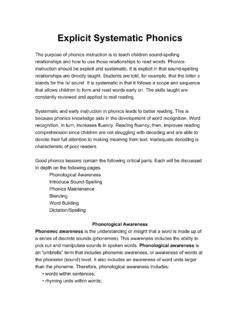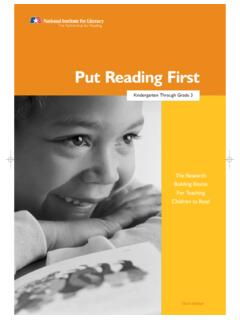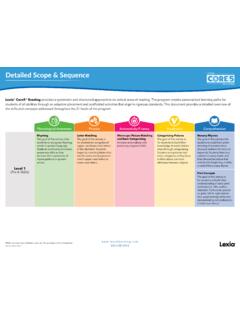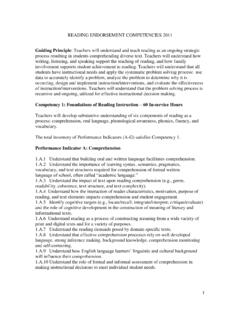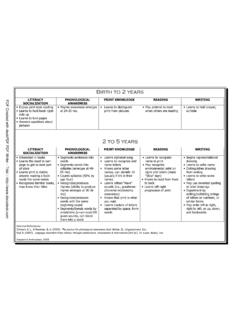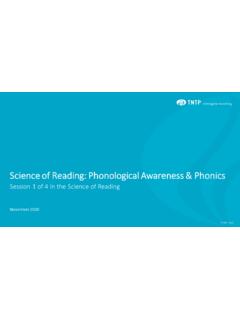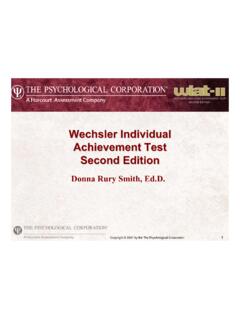Transcription of Effective Practices for Developing the Literacy Skills of ...
1 Effective Practices for Developing Literacy Skills of English Language Learners in the English Language Arts ClassroomSultan TurkanJerome BicknellAndrew CroftFebruary 2012 Research Report ETS RR 12-03 Effective Practices for Developing the Literacy Skills of English Language Learners in the English Language Arts Classroom Sultan Turkan, Jerome Bicknell, and Andrew Croft ETS, Princeton, New Jersey February 2012 Technical Review Editor: Daniel R. Eignor Technical Reviewers: John Young and Courtney Bell Copyright 2012 by Educational Testing Service. All rights reserved. ETS, the ETS logo, and LISTENING. LEARNING. LEADING are registered trademarks of Educational Testing Service (ETS).
2 As part of its nonprofit mission, ETS conducts and disseminates the results of research to advance quality and equity in education and assessment for the benefit of ETS s constituents and the field. To obtain a PDF or a print copy of a report, please visit: i Abstract This paper is a review of literature presenting instructional strategies based on normative as well as empirical arguments which have proven to be Effective in envisioning what all teachers need to know and be able to do to teach English language arts (ELA) to English language learners (ELLs). The studies selected for review address what is particular to teaching ELA to ELLs. The paper is divided into two main sections: (a) teachers linguistic Practices and (b) teachers pedagogical Practices .
3 In the first section, we report on the studies that analyze teachers understanding of linguistics and present implications for their instruction of ELLs. Three areas of Effective practice are emphasized based on the particular aspects of teaching ELA to ELLs. The first area is that teachers should recognize that Literacy Skills in ELLs native languages might influence the ways in which ELLs process linguistic information in English. The second area highlights the argument that teachers should find ways to facilitate ELLs mastery of academic vocabulary. The third area covers the significance of enhancing ELLs metacognitive reading Skills . In the second section, on teacher pedagogical Practices , we discuss two broad pedagogical Skills that emerge from both the normative and empirical studies reviewed and are closely related: (a) the teachers ability to help ELLs construct meaning from the texts or speech represented in the ELA classroom and (b) the teachers ability to engage ELLs in actively learning to read and write.
4 The paper ends with a summary and a brief reflective statement on the limitations of the review of the literature. Key words: English language learners, ELLs, understanding teaching quality, Literacy Skills , English language arts, English language arts classrooms ii Table of Contents Page Methodology .. 2 Teachers Understanding of Linguistics .. 3 Recognizing the Interaction of ELLs Native Language With English .. 4 Developing ELLs Academic Vocabulary .. 6 Improving ELLs Metalinguistic Knowledge in Reading .. 13 Summary .. 15 Pedagogical Practices in Teaching Reading and Writing to ELLs .. 16 Helping ELLs Construct Meaning .. 16 Building From the Known to the Unknown.
5 17 Using Multiple Modalities .. 19 Designing Collaborative Activities .. 20 Engaging ELLs in Reading and Writing .. 22 Summary and Conclusion .. 24 References .. 26 1 In 2008, million, or 21% of school-age children (ages 5 17) spoke a language other than English at home, an increase from 18% in 2000, and from 9% in 1979 ( Department of Education, National Center for Education Statistics, 2010). The number of school-age immigrant children is projected to grow from million in 2005 to million in 2020 (Kirsch, Braun, Yamamoto, & Sum, 2007; Passel & Cohn, 2008). Within this population, the school enrollment of students considered to be English language learners (ELLs) increased by approximately 51%, from million students in 1998 1999 to million in 2008 2009 according to state level data (National Clearinghouse for English Language Acquisition, 2011).
6 The number of ELLs enrolling in public schools is exponentially increasing throughout the United States, even in regions that traditionally have not been accustomed to linguistic and cultural diversity (Reeves, 2009). As the ELL student population is growing rapidly, ELL achievement gaps in academic subjects still persist. In reading, for instance, the results of the National Assessment of Educational Progress (NAEP) in 2005 showed that 71% of ELLs at grade 8 scored below Basic as compared to 27% of non-ELLs (Perie, Grigg, & Donahue, 2005). The results of the 2007 NAEP indicated that 70% of ELLs at grade 8 scored below Basic in reading as compared to 24% of non-ELLs.
7 Similarly, NAEP results in 2009 at grade 8 indicated that 74% of ELLs scored below Basic in reading but only 22% of non-ELLs scored below Basic. In terms of the development of ELLs reading Skills , there is consensus in the literature that limited language proficiency constrains reading development (August & Hakuta, 1997; August & Shanahan, 2006; Francis, Rivera, Lesaux, Kieffer, & Rivera, 2006). However, though reading is often associated (almost exclusively) with English language arts (ELA), it is central for student learning in all the other content areas, as captured in Jeanne Chall s (1983) idea of reading to learn (as Francis et al., 2006). That is, reading is an essential mediator for successful learning in all content areas (Brown, 2007).
8 Given the increasing population of ELLs in the United States and the critical nature of their reading proficiency for academic success, this review of literature focuses on what teachers can do to enhance ELLs reading abilities in English to improve their Literacy Skills in the 2 English language arts (ELA) as well as other content areas (mathematics, science, and social studies). The warrants presented in this paper draw on (a) empirical connections to student learning, (b) theoretical relationships to student understanding, and (c) normative claims about what matters in relation to Effective practice. The studies discussed in this paper are neither exhaustive nor conclusive of what teachers should be able to do to improve ELLs Literacy Skills .
9 Given the dynamic field of teaching ELA to ELLs, the studies reviewed most likely do not present a comprehensive picture of all possible Effective instructional Practices . However, for the purpose of contributing to the dialogue about what teachers of ELLs should be able to do to improve ELLs reading Skills in and out of ELA classes, we present a selected set of Effective teaching Practices culled from the literature. Methodology In our survey of literature, a wide range of databases was searched, including ERIC, Academic Search Premier, PsychInfo, Education Research Complete, Education Full Text, JSTOR, and Wilson Select Plus. Using the keyword teaching content to ELLs, the search yielded 57 peer-reviewed research and conceptual papers published since 1998.
10 Other keywords, developed to integrate all the content areas that ELLs are held accountable for, were teaching science to ELLs, teaching mathematics to ELLs, and teaching ELA to ELLs. We included works prior to 1998 that we deemed important to consult because they were cited in multiple sources. We selected studies according to the following criteria: (a) the studies needed to report on empirical and/or normative arguments associated with Effective teaching Practices ; and (b) the studies needed to report on particular aspects of teaching ELLs in ELA classrooms. Some of the studies that met the inclusion criteria were subjected to ancestral search (using their references).










